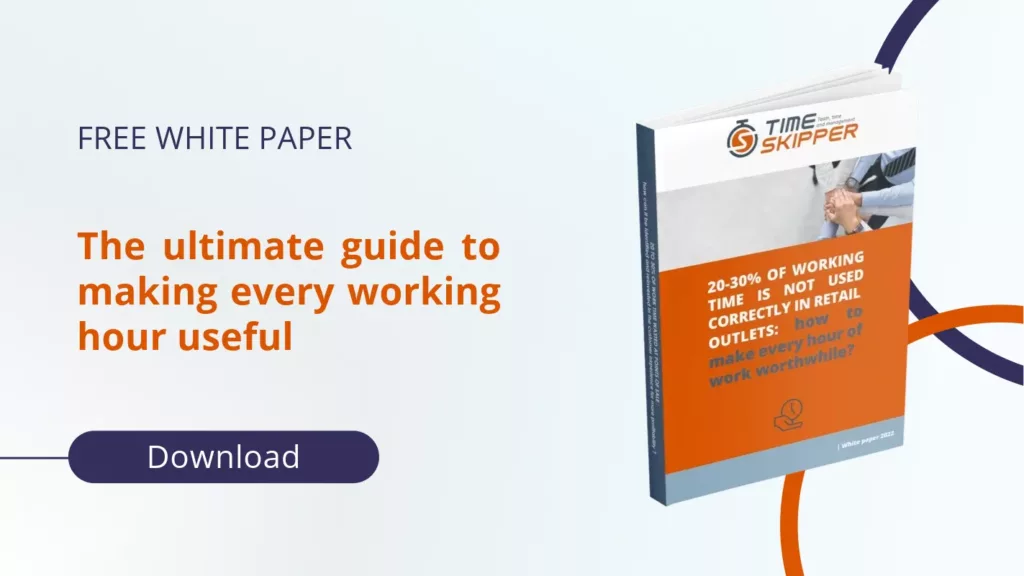Introduction
Store absenteeism: a puzzle you no longer have to endure!
Imagine yourself juggling disrupted schedules, depleted teams, and increasingly demanding customers. Stressful, right? Yet this is the daily reality for many store managers. Just picture the impact on productivity, customer service quality, and team cohesion…
But don’t panic! The good news is, there are straightforward solutions available to prevent and manage absenteeism in stores without breaking a sweat. We’ll walk you through it!
I) Why so much absenteeism in stores?
Ever heard the saying “where there’s smoke, there’s fire”? So, why are there so many absences in retail? Although it’s impossible to list every reason, as some may vary from one store or employer to another, we can highlight the most common ones. Remember, this isn’t an accusation, just common trends linked to store absenteeism.
Challenging working conditions
First off, working conditions weigh heavily. Employees in the retail sector often face irregular schedules, weekend openings, and physically demanding tasks. Accumulated fatigue increases risks of sickness or burnout absences. Added stress from potential workload overloads, absences, or poor management and organization further compounds this issue. According to a 2024 survey by ADP Research, 73% of retail, hospitality, and leisure employees experience workplace stress at least weekly. Combined with high expectations, this quickly leads to demotivation.
Occupational illnesses and workplace accidents also contribute significantly.
Common illnesses, musculoskeletal disorders from repetitive tasks, and psychological issues such as stress or burnout—ranging from days to months—are frequent absenteeism reasons in the sector.
Unmet need for recognition
Lack of recognition also plays a critical role. When employees feel undervalued or unsupported by management, motivation quickly fades. Predictably, this often leads to frequent absences or resignations. A 2021 study by Hays revealed that 44% of professionals surveyed had already quit their jobs due to lack of recognition. This highlights the importance of valuing employees to reduce absenteeism.
Generation clash!
Generation Z views work differently from previous generations. While older generations often built their careers within a single company, today’s youth could change jobs up to seven times. Retention becomes tricky without understanding their priorities.
Their expectations are clear: 77% prioritize work-life balance and mental health. Stressful responsibilities no longer appeal to them, and physical jobs are less attractive compared to service sector roles. This shift incurs multiple costs, including early departures and frequent sick leave, indicating deeper underlying issues.
Is it a lack of interest in work or a gap between differing professional visions? Previous generations tried adapting, yet absenteeism rose 30% in four years. Instead of determining whose work vision is better, perhaps seeking common ground is the answer.
Or perhaps time itself will adjust these perspectives?
These factors combined reveal a gap between current job constraints and employee expectations—an issue resolvable by revisiting managerial fundamentals.
II) How to prevent absenteeism?
Having identified the main absenteeism drivers, what now? While the task might seem daunting, it doesn’t have to be.
Let’s revisit core managerial practices that boost motivation:
Meaningful work
A motivated employee understands how their role contributes to collective success. Seeing their direct impact on team or store outcomes makes them feel valued and adds meaning to their role. Given the challenging nature of retail roles, employees must find fulfillment, particularly through serving customers and enhancing their shopping experience.
Clear expectations
Employees need clarity regarding expectations and the feasibility of set objectives. Clear expectations boost employees’ confidence, preparing them better for their tasks. Conversely, poorly defined, vague, or unrealistic goals foster frustration, stress, and incompetence, thus increasing absenteeism risks.
Recognition
Feeling valued and acknowledged motivates employees to show up. Recognition extends beyond monetary incentives. A simple “thank you,” casual check-ins, genuine encouragement during briefings, or highlighting achievements considerably boost a sense of belonging and satisfaction.
Balance between kindness and firmness in management
In high-pressure environments, employees must feel supported, heard, and respected. Benevolent, transparent management based on active listening fosters trust and safety, decreasing stress-related or unresolved conflict absences. Yet kindness shouldn’t override decisiveness. Managers must balance empathy with firmness to maintain authority while fostering serenity.
Now, how do you apply this practically? This is where TimeSkipper steps in!
III) How TimeSkipper helps prevent and manage absenteeism?
Absenteeism prevention is a major priority, and TimeSkipper ensures its sustainability.
Greater fairness is achieved by allocating the workload according to the time available to each employee. To achieve this, you need a global view of the workload to be carried out. TimeSkipper’s solution makes this possible.
At a glance, the manager can identify which tasks need to be reallocated and smoothed to achieve greater fairness.
Daily briefings are essential to offer employees a clear view of team organization:
-
How workload is allocated
-
What is expected individually, clarifying their roles
-
How their tasks contribute to team success, enhancing their value
-
Their essential role within the team, reinforcing belonging
These daily exchanges build team cohesion and highlight management that’s both compassionate and firm, rooted in active listening, transparency, and explicit recognition of individual and collective contributions.
Additionally, recognizing employees through guaranteed training slots strengthens their engagement. However, identifying appropriate training times can be challenging—TimeSkipper pinpoints ideal moments for scheduling.
Still, unexpected absences occur. TimeSkipper simplifies their management by immediately clarifying operational impacts, allowing managers to quickly identify and reassign priority tasks. This clarity enables effective task reorganization, maintaining operational continuity without overwhelming staff. This pragmatic approach ensures teams remain efficient, calm, and committed, even during unforeseen challenges.
Conclusion
Absenteeism isn’t inevitable! TimeSkipper enables efficient responses and reduces absenteeism. Ready to transform a management puzzle into an advantage?
TimeSkipper helps restore work meaning and strengthens team engagement.






